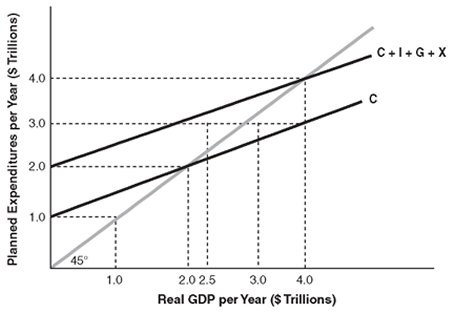To achieve long-run equilibrium in an economy with a recessionary gap, without the use of stabilization policy, the inflation rate must:
A. not change.
B. increase.
C. decrease.
D. either increase or decrease depending on the relative shifts of AD and AS.
Answer: C
You might also like to view...
In the United States over the last 50 years,
A) the labor force participation rate for women has increased to match that for women in other developed countries. B) the labor force participation rate for women has increased to near 60 percent. C) the change in men's labor force participation rate explains the behavior of the unemployment rate. D) both women's and men's labor force participation rates have increased due to technology. E) women's earning power has remained fairly constant.
 In the above figure, at the equilibrium level of real GDP, there is
In the above figure, at the equilibrium level of real GDP, there is
A. a negative tax rate. B. zero saving. C. negative saving. D. positive saving.
If the opportunity costs of producing a good increase as more of that good is produced, the economy's production possibility frontier will be
A. a negatively sloped straight line. B. negatively sloped and "bowed inward" toward the origin. C. negatively sloped and "bowed outward" from the origin. D. a positively sloped straight line.
One important reason why the Solow residual may be strongly procyclical even if the actual technology used in production doesn't change is that
A. resource utilization is procyclical. B. demand shocks are the dominant force determining the business cycle. C. the coefficients (a and 1 - a) on capital and labor in the production function are procyclical. D. employment is procyclical.